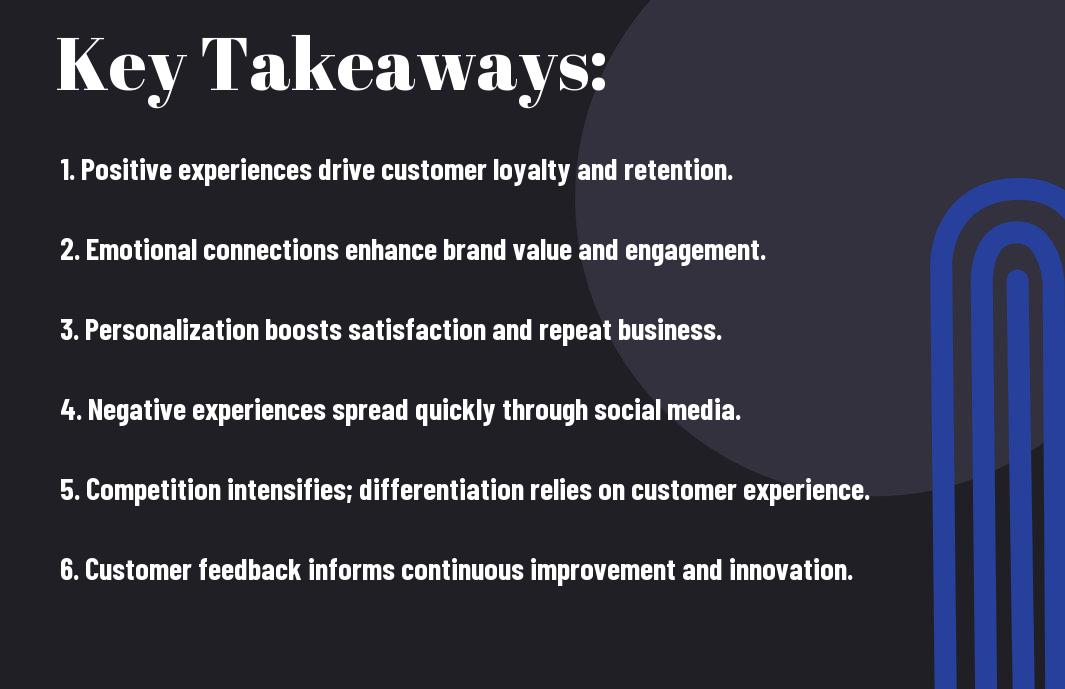
There’s no denying that in today’s competitive market, customer experience plays a pivotal role in your business’s success. As consumers become more discerning and expect seamless interactions, understanding and enhancing their experience has never been more vital. Focusing on customer satisfaction not only fosters loyalty but also drives word-of-mouth marketing, ultimately leading to increased revenue. In this blog post, we will explore the key reasons why prioritizing customer experience should be at the forefront of your business strategy.

The Evolution of Customer Experience
Your perception of customer experience has transformed dramatically over the years. It began as a transactional interaction, focusing purely on sales, but has evolved into a holistic journey where emotions, connections, and brand loyalty take center stage. Today, businesses recognize that creating meaningful experiences at every touchpoint is crucial for building lasting relationships with customers.
Historical Context
Around the turn of the 20th century, businesses prioritized product quality and price, believing these factors would suffice for customer retention. As competition intensified, companies started to realize that exceptional service could set them apart. The rise of brand loyalty programs in the latter part of the century marked the beginning of a more consumer-centric approach, laying the foundation for the evolution of customer experience.
Modern Expectations
Between the age of information and the digital transformation, customer expectations have reached new heights. Consumers now demand seamless interactions across various channels, personalized services, and instantaneous responses. They are well-informed, empowered, and less tolerant of mediocre experiences, which has made it crucial for businesses to adapt and innovate continuously to meet these evolving demands.
Understanding what your customers expect in today’s digital landscape is vital. Personalized experiences, quick resolutions, and a consistent brand presence across all platforms are paramount. Your customers anticipate convenience and efficiency that align with their busy lifestyles. As a result, businesses that fail to adapt will likely fall behind, making it imperative for you to prioritize enhancing customer experience in your strategy.
The Impact of Technology on Customer Experience
Assuming you are navigating today’s competitive landscape, you’ll quickly realize that technology significantly shapes customer experience. With the rapid advancement of digital tools, your interactions with customers can be streamlined, tailored, and elevated. By leveraging technology effectively, you can enhance communication, gather valuable insights, and ultimately foster customer loyalty.
Digital Transformation
One of the most significant shifts in modern business is digital transformation. This entails integrating advanced technologies into every facet of your organization, empowering you to improve operational efficiency and enhance customer interactions. By embracing digital tools, you can provide seamless services that cater to evolving consumer expectations.
Personalization and Automation
Experience the power of personalization and automation in your customer interactions to create a more engaging experience. By utilizing data analytics, you can tailor communications, recommendations, and offers specifically for each customer, ensuring they feel valued and understood. Automation streamlines your processes, allowing you to respond to customer inquiries rapidly and efficiently.
Digital advancements enable you to harness data effectively, paving the way for personalized engagements that resonate with your audience. By analyzing customer behaviors, preferences, and feedback, you can create targeted marketing campaigns that cultivate deeper connections. Additionally, automation tools can handle routine tasks and inquiries, allowing your team to focus on nurturing relationships and driving customer satisfaction. This combination of personalization and automation not only enhances the customer experience but also boosts your operational performance.
The Role of Customer Feedback
Once again, customer feedback serves as a vital tool that shapes your business strategy. It acts as a window into the thoughts, feelings, and expectations of your customers, enabling you to make informed decisions that enhance their overall experience. By actively engaging with feedback, you can identify strengths and weaknesses in your service or product, helping you create targeted improvements that resonate with your audience.
Collecting Insights
Above all, gathering feedback from your customers should be a systematic process. Utilize surveys, social media, and direct communications to capture their opinions and experiences. The more channels you use, the richer your insights will be. Regularly asking for feedback not only demonstrates your commitment to improving but also encourages customers to share their thoughts, giving you a comprehensive understanding of their needs.
Implementing Changes
Changes based on customer feedback are imperative for nurturing relationships and ensuring satisfaction. When you act on insights, you demonstrate that you value your customers’ opinions, which can significantly impact loyalty and trust. Implementing these changes shows your willingness to adapt and grow, ultimately fostering a more positive customer experience.
Insights gathered from your customers can guide the specific changes you make to improve their experience. Analyze the feedback to pinpoint recurring themes or concerns, and prioritize which adjustments need immediate attention. Whether it’s tweaking a product feature or altering your service approach, the key is to ensure your customers feel heard and valued. By following through on their suggestions, you cultivate a culture of responsiveness that not only enhances their experience but strengthens your brand reputation.
Building a Customer-Centric Culture
After recognizing the importance of customer experience, it becomes important to foster a customer-centric culture within your organization. This means aligning your values, practices, and strategies around the needs and preferences of your customers. A robust customer-centric culture empowers your team to prioritize customer satisfaction, creating a more meaningful and lasting relationship between your brand and its audience.
Leadership Commitment
Building a successful customer-centric culture starts at the top. Your leadership team must visibly commit to prioritizing customer experience across all departments. By modeling this behavior and integrating customer feedback into strategic decisions, you set the tone for your organization, demonstrating that every employee plays an integral role in shaping the customer journey.
Employee Engagement
Engagement is vital for empowering your employees to embrace a customer-centric approach. When your team understands the impact they have on customer interactions, they become more motivated to deliver exceptional service. This positive connection leads to improved performance, as happy employees often translate to satisfied customers.
Another key aspect of employee engagement is providing the necessary resources and training to enhance their skills and knowledge. By investing in your team’s development, you encourage them to take ownership of customer interactions. When employees feel equipped and appreciated, they are more likely to go above and beyond, creating memorable experiences that resonate with your customers.
Measuring Customer Experience Success
Keep in mind that measuring customer experience is important for understanding how well you’re meeting your customers’ needs. By evaluating various touchpoints throughout the customer journey, you can identify areas for improvement and enhance overall satisfaction. Through effective measurement, you will be able to adapt your strategies and create a more positive experience for your customers.
Key Performance Indicators
To accurately gauge your customer experience success, it’s important to establish Key Performance Indicators (KPIs). These metrics will help you quantify aspects like customer satisfaction, net promoter scores, and customer retention rates, giving you a clear picture of how well you’re performing and where enhancements may be needed.
Customer Satisfaction Surveys
Behind every great customer experience lies an understanding of customer satisfaction, which you can gain by utilizing customer satisfaction surveys. These surveys are invaluable tools for gathering direct feedback from your customers, allowing you to pinpoint what they like and what can be improved.
Even a simple survey can reveal important insights about your customers’ feelings and expectations. Tailoring your questions to address specific aspects of their experience will lead to more actionable data. By analyzing the results, you can make informed decisions that directly impact your product or service, ultimately enhancing your overall customer experience and fostering long-term loyalty.
Trends Shaping the Future of Customer Experience
Not only is customer experience evolving, but you must also stay ahead of emerging trends that shape how consumers interact with brands. From technological advancements to increasing demands for sustainability, understanding these trends is vital for creating meaningful connections with your customers. As competition intensifies, being adaptable and proactive will set you apart and ensure you cater to the expectations of a more informed consumer base.
Omnichannel Experiences
One of the most important trends in customer experience is the shift towards omnichannel strategies. You now face a consumer landscape where customers expect seamless transitions between platforms, whether they are shopping online, in-store, or using mobile applications. By effectively integrating all your communication channels, you can provide a cohesive and personalized experience that meets customers exactly where they are.
Sustainability and Ethical Practices
Against the backdrop of increasing consumer awareness, sustainability and ethical practices have become vital considerations for your brand. Today’s customers are not just interested in products; they are drawn to brands that align with their values, particularly regarding environmental responsibility and social ethics. Adopting sustainable practices can cultivate customer loyalty and trust, making a positive impact on your bottom line.
But it’s necessary to go beyond merely adopting green initiatives. You should actively communicate your efforts to your consumers, showcasing transparency in your practices. When you demonstrate genuine commitment to sustainability and ethical considerations, you build an emotional connection with your audience. This helps create brand advocates who appreciate your values and are likely to choose your products over competitors, driving long-term success.
To wrap up
Now, as you navigate an increasingly competitive marketplace, prioritizing customer experience can significantly enhance your business success. By understanding your customers’ needs and providing personalized interactions, you foster loyalty and differentiate your brand. Investing in customer experience not only boosts satisfaction but also cultivates strong relationships, ultimately leading to increased retention and revenue. Embrace this focus to adapt and thrive, ensuring that your customers feel valued and understood in every interaction.
Leave a Reply